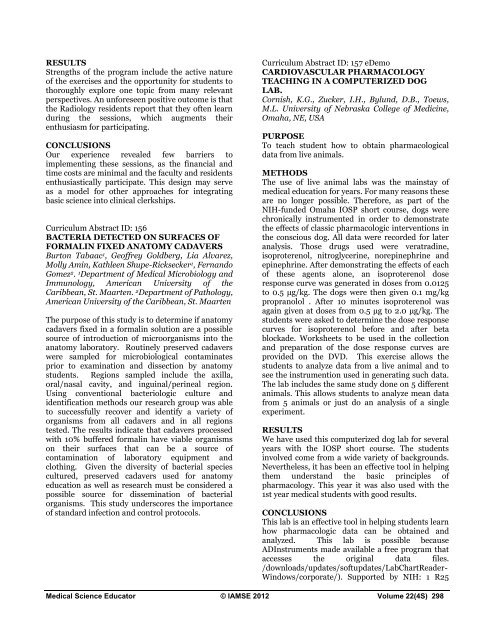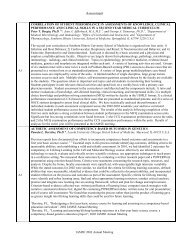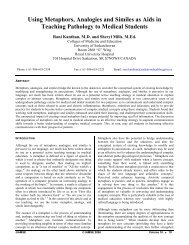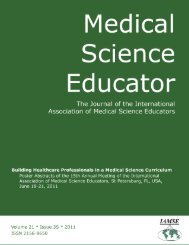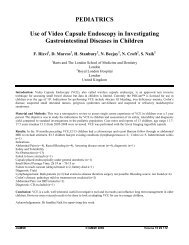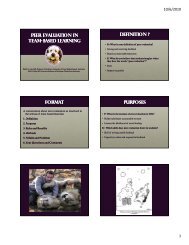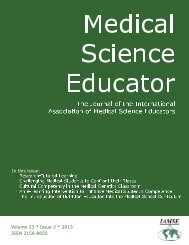Click here to view complete journal in pdf-format - IAMSE
Click here to view complete journal in pdf-format - IAMSE
Click here to view complete journal in pdf-format - IAMSE
You also want an ePaper? Increase the reach of your titles
YUMPU automatically turns print PDFs into web optimized ePapers that Google loves.
RESULTS<br />
Strengths of the program <strong>in</strong>clude the active nature<br />
of the exercises and the opportunity for students <strong>to</strong><br />
thoroughly explore one <strong>to</strong>pic from many relevant<br />
perspectives. An unforeseen positive outcome is that<br />
the Radiology residents report that they often learn<br />
dur<strong>in</strong>g the sessions, which augments their<br />
enthusiasm for participat<strong>in</strong>g.<br />
CONCLUSIONS<br />
Our experience revealed few barriers <strong>to</strong><br />
implement<strong>in</strong>g these sessions, as the f<strong>in</strong>ancial and<br />
time costs are m<strong>in</strong>imal and the faculty and residents<br />
enthusiastically participate. This design may serve<br />
as a model for other approaches for <strong>in</strong>tegrat<strong>in</strong>g<br />
basic science <strong>in</strong><strong>to</strong> cl<strong>in</strong>ical clerkships.<br />
Curriculum Abstract ID: 156<br />
BACTERIA DETECTED ON SURFACES OF<br />
FORMALIN FIXED ANATOMY CADAVERS<br />
Bur<strong>to</strong>n Tabaac 1 , Geoffrey Goldberg, Lia Alvarez,<br />
Molly Am<strong>in</strong>, Kathleen Shupe-Ricksecker 1 , Fernando<br />
Gomez 2 . 1 Department of Medical Microbiology and<br />
Immunology, American University of the<br />
Caribbean, St. Maarten. 2 Department of Pathology,<br />
American University of the Caribbean, St. Maarten<br />
The purpose of this study is <strong>to</strong> determ<strong>in</strong>e if ana<strong>to</strong>my<br />
cadavers fixed <strong>in</strong> a formal<strong>in</strong> solution are a possible<br />
source of <strong>in</strong>troduction of microorganisms <strong>in</strong><strong>to</strong> the<br />
ana<strong>to</strong>my labora<strong>to</strong>ry. Rout<strong>in</strong>ely preserved cadavers<br />
were sampled for microbiological contam<strong>in</strong>ates<br />
prior <strong>to</strong> exam<strong>in</strong>ation and dissection by ana<strong>to</strong>my<br />
students. Regions sampled <strong>in</strong>clude the axilla,<br />
oral/nasal cavity, and <strong>in</strong>gu<strong>in</strong>al/per<strong>in</strong>eal region.<br />
Us<strong>in</strong>g conventional bacteriologic culture and<br />
identification methods our research group was able<br />
<strong>to</strong> successfully recover and identify a variety of<br />
organisms from all cadavers and <strong>in</strong> all regions<br />
tested. The results <strong>in</strong>dicate that cadavers processed<br />
with 10% buffered formal<strong>in</strong> have viable organisms<br />
on their surfaces that can be a source of<br />
contam<strong>in</strong>ation of labora<strong>to</strong>ry equipment and<br />
cloth<strong>in</strong>g. Given the diversity of bacterial species<br />
cultured, preserved cadavers used for ana<strong>to</strong>my<br />
education as well as research must be considered a<br />
possible source for dissem<strong>in</strong>ation of bacterial<br />
organisms. This study underscores the importance<br />
of standard <strong>in</strong>fection and control pro<strong>to</strong>cols.<br />
Curriculum Abstract ID: 157 eDemo<br />
CARDIOVASCULAR PHARMACOLOGY<br />
TEACHING IN A COMPUTERIZED DOG<br />
LAB.<br />
Cornish, K.G., Zucker, I.H., Bylund, D.B., Toews,<br />
M.L. University of Nebraska College of Medic<strong>in</strong>e,<br />
Omaha, NE, USA<br />
PURPOSE<br />
To teach student how <strong>to</strong> obta<strong>in</strong> pharmacological<br />
data from live animals.<br />
METHODS<br />
The use of live animal labs was the ma<strong>in</strong>stay of<br />
medical education for years. For many reasons these<br />
are no longer possible. T<strong>here</strong>fore, as part of the<br />
NIH-funded Omaha IOSP short course, dogs were<br />
chronically <strong>in</strong>strumented <strong>in</strong> order <strong>to</strong> demonstrate<br />
the effects of classic pharmacologic <strong>in</strong>terventions <strong>in</strong><br />
the conscious dog. All data were recorded for later<br />
analysis. Those drugs used were veratrad<strong>in</strong>e,<br />
isoproterenol, nitroglycer<strong>in</strong>e, norep<strong>in</strong>ephr<strong>in</strong>e and<br />
ep<strong>in</strong>ephr<strong>in</strong>e. After demonstrat<strong>in</strong>g the effects of each<br />
of these agents alone, an isoproterenol dose<br />
response curve was generated <strong>in</strong> doses from 0.0125<br />
<strong>to</strong> 0.5 μg/kg. The dogs were then given 0.1 mg/kg<br />
propranolol . After 10 m<strong>in</strong>utes isoproterenol was<br />
aga<strong>in</strong> given at doses from 0.5 μg <strong>to</strong> 2.0 μg/kg. The<br />
students were asked <strong>to</strong> determ<strong>in</strong>e the dose response<br />
curves for isoproterenol before and after beta<br />
blockade. Worksheets <strong>to</strong> be used <strong>in</strong> the collection<br />
and preparation of the dose response curves are<br />
provided on the DVD. This exercise allows the<br />
students <strong>to</strong> analyze data from a live animal and <strong>to</strong><br />
see the <strong>in</strong>strumention used <strong>in</strong> generat<strong>in</strong>g such data.<br />
The lab <strong>in</strong>cludes the same study done on 5 different<br />
animals. This allows students <strong>to</strong> analyze mean data<br />
from 5 animals or just do an analysis of a s<strong>in</strong>gle<br />
experiment.<br />
RESULTS<br />
We have used this computerized dog lab for several<br />
years with the IOSP short course. The students<br />
<strong>in</strong>volved come from a wide variety of backgrounds.<br />
Nevertheless, it has been an effective <strong>to</strong>ol <strong>in</strong> help<strong>in</strong>g<br />
them understand the basic pr<strong>in</strong>ciples of<br />
pharmacology. This year it was also used with the<br />
1st year medical students with good results.<br />
CONCLUSIONS<br />
This lab is an effective <strong>to</strong>ol <strong>in</strong> help<strong>in</strong>g students learn<br />
how pharmacologic data can be obta<strong>in</strong>ed and<br />
analyzed. This lab is possible because<br />
ADInstruments made available a free program that<br />
accesses the orig<strong>in</strong>al data files.<br />
/downloads/updates/softupdates/LabChartReader-<br />
W<strong>in</strong>dows/corporate/). Supported by NIH: 1 R25<br />
Medical Science Educa<strong>to</strong>r © <strong>IAMSE</strong> 2012 Volume 22(4S) 298


